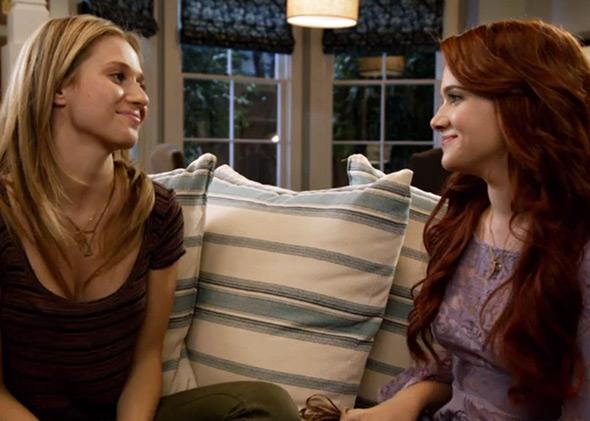WiJiMo,
I’ll admit it, television shocked me in 2014. I’m not talking about forbidden acts—though that glimpse at parental intimacy in The Americans, the frantic early anger-banging of You’re the Worst, and Ilana’s habit of Skyping Abbi while she’s getting busy with Lincoln on Broad City all felt barrier-busting in their own ways. It was that I often had the sense that some key human experiences were making their TV debuts, nearly 90 years into the medium’s history.
Let me give you some examples. I was very skeptical of MTV’s Faking It at the outset. The notion of two shockingly attractive teens pretending to be a lesbian couple to boost their popularity with fellow students at a progressive Austin, Texas, high school seemed far-fetched at best—and a shameless opportunity for some soft-focus make-out sessions at worst. Sure enough, there was more than a little David Hamilton–style pandering. But underneath all that was an unmistakably queer sensibility keen to explore new territory. Take, for instance, the moment when bold, brassy Shane (an acidic Michael Willett) got to show how much his closeted boyfriend’s public denial of their relationship hurt him. A few years ago, that storyline would’ve been nothing more than fodder for arch quips and a predictable denouement.
Of course, Shane’s relationship woes were nothing compared with the faux homos of the title. In the very first episode, Amy (Rita Volk) realized that she loved Karma (Katie Stevens) like that. I can’t even imagine this situation making it to the screen at any point in the past—unless the lesbian was some kind of predatory creep—but Faking It has sensitively shown Amy figuring out that she’s attracted to her best friend, telling her how she feels, accepting that Karma adores her but not in the same way, finding a fantastic first girlfriend, and not being able to shake the feeling that the woman she really wants to get busy with in the bedroom is … Karma. Many a lesbian has survived some variation on this experience (as have lots of straight women with lesbian best friends), but I never thought I’d see it on MTV.
A similar scenario played out between orientation-discordant best pals Poussey and Taystee in Orange Is the New Black. Their relationship is lovely, nourishing, and—after the evil Vee stuck her nasty oar in—heartbreaking. Willa, you’re right, of course, that “attractive people making out is a bedrock pleasure principle of all moving images,” but OITNB gets unprecedented mileage out of hiding its characters’ attractiveness. Don’t get me wrong, those women are all gorgeous, but the hideous institutional lighting, those shapeless beige uniforms, and general prison blurkitude remove any lingering traces of glamour. The sex is messy, a little sordid, completely unromantic—and utterly convincing.
The Good Wife has already come up a bunch, and—despite a few missteps—sex and intimacy is yet another thing it does exceedingly well. So far in Season 6, Alicia’s been a bit too distracted for the pleasures of the flesh, but as usual Kalinda has been causing orgasms all over Chicago. In an era where more and more channels are showing more and more flesh, The Good Wife is one of the hottest shows on television without straying too far from Hays Code–style limits. A tight close-up on someone biting their lip is all it takes to convey utter satisfaction. Why, I believe we saw Kalinda let her hair down for the very first time just a few episodes ago.
The Good Wife’s showrunners, Michelle and Robert King, are the most accomplished jugglers on television. The Good Wife seamlessly combines procedural elements, political intrigue, social issues, family drama, conflicted romance, and sexy times. If you watch an episode armed with a stopwatch—as I have on occasion—it’s striking how much they can do in just a few minutes. The case of the week usually takes up less than half of the episode, but you wouldn’t know it. Other than some complaints about Kalinda—and as much as I have adored the character, I agree with Willa that it’s time for her to go—I rarely feel that the writers’ need to find time for everyone is crowding out the story. (This requires ruthlessness—and if you’ll forgive me returning, once again, to Season 2 of The Bridge, I suspect it might have been renewed if showrunner Elwood Reid could’ve said some farewells. But he fell in love with characters like marble-mouthed Steven Linder, and everything got a bit out of hand.)
When this is all over, let’s get together to make beer-can men,
June
